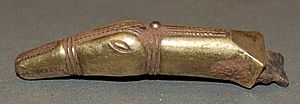George Speake facts for kids
Quick facts for kids
George Speake
FSA
|
|
|---|---|
| Nationality | English |
| Education | Slade School of Fine Art |
| Alma mater | University of Oxford |
| Known for | Leading authority on Anglo-Saxon animal art |
| Scientific career | |
| Fields | Art history and archaeology |
| Institutions | Institute of Archaeology at Oxford |
| Thesis | The beginnings and developments of Salin's style II in England (1974) |
| Doctoral advisor | Sonia Chadwick Hawkes |
| Other academic advisors |
|
George Speake is an English expert in art history and archaeology. He is known as a top authority on Anglo-Saxon animal art. Anglo-Saxons were people who lived in England a long time ago.
Mr. Speake is an Honorary Research Fellow at the Institute of Archaeology at Oxford. He also works with the Staffordshire Hoard conservation team. He helps to put back together the famous Staffordshire helmet.
His Early Life and Studies
George Speake went to the Slade School of Fine Art in the 1960s. Later, in the 1970s, he studied at the University of Oxford. There, he attended St John's College and the Institute of Archaeology.
At Oxford, he learned from famous archaeologists Christopher and Sonia Hawkes. In 1974, he earned his Ph.D. His special study was about Anglo-Saxon animal art.
What He Does
George Speake is an expert in Anglo-Saxon art and its symbols. As of 2025, he is still working on putting together the Staffordshire helmet. This helmet was found in more than 1,000 pieces!
He also worked on the Prittlewell burial. This was another important archaeological discovery. Mr. Speake has also taught fine art and art history.
In 2014, he helped write a book about the Staffordshire Hoard. The book is called Beasts, Birds and Gods: Interpreting the Staffordshire Hoard. In it, he described an "eyeless, open-jawed serpent" on the helmet's cheek guard.

His Important Research
Mr. Speake's 1980 book, Anglo-Saxon Animal Art and its Germanic Background, is very important. It came from his Ph.D. work. This book was a big step forward in understanding Anglo-Saxon art styles.
The book looked closely at "style II" art. This was a type of animal decoration used in Northern Europe. It was popular from the mid-6th century AD to the end of the 7th century.
Before Speake's book, style II was not well understood. It was thought to be used mainly by the upper classes. You can see examples of this art on objects from the Sutton Hoo ship-burial. It is also found in the Vendel boat graves.
Speake's work covered every known example of style II art up to 1974. He also showed that this art style came to England from Denmark, Norway, and Sweden.

